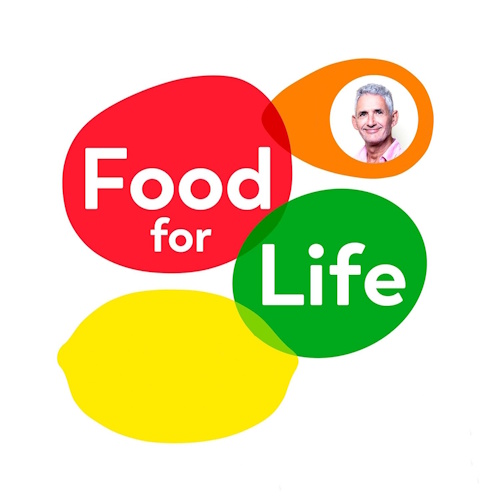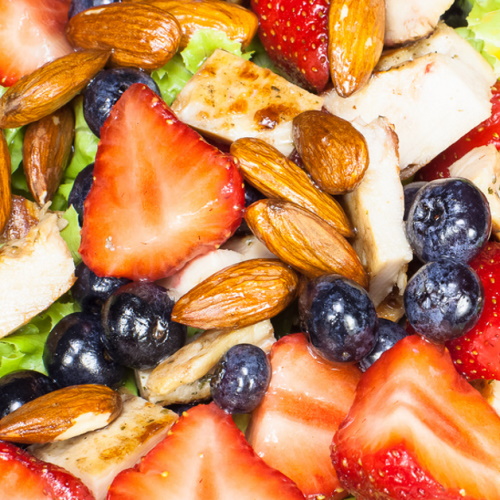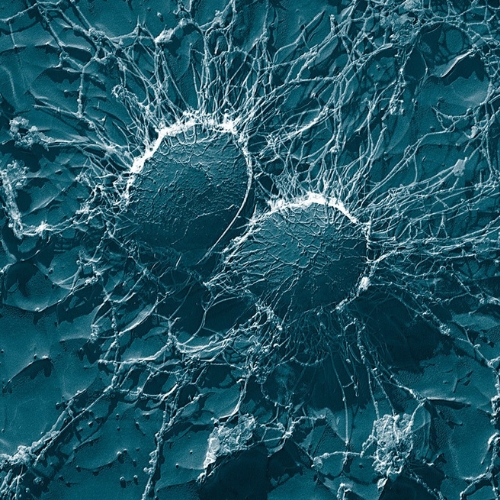Food for Life
The new science of eating well by Tim Spector
Food is our greatest ally for good health, but the question of what to eat has never seemed so complicated.
In Food for Life Tim Spector draws on over a decade of cutting-edge scientific research, along with his own personal insights, to deliver a new and comprehensive guide to what we should all know about food today.
Taking a wide-angle lens on everything from environmental impact and food fraud to allergies and deceptive labelling, Spector shows us the many wondrous and surprising properties of everyday foods, which scientists are only just beginning to understand.
Food for Life provides practical insights and a new approach on how to eat for our health and the health of the planet.
Food for Life Book Review
Food for Life is an enjoyable mix of diet tips, interesting trivia and a reference manual good enough for anyone who isn’t a professional dietician. Part one is a general introduction to food, the microbiome, their interaction with each other and how our food choices impact the planet. Then, part two goes into the health benefits and harms of individual foods, broken up into high-level categories such as vegetables, fish and cheese – with some unexpected highlights from nutrition studies, e.g. only very minor benefits of brown over white rice, and likewise, no differences between white or red meat consumption. There is a summary at the end of each chapter if you just want to jump to his key points and conclusions. Finally, part three is a reference section full of useful reference tables such as polyphenol content of fruits, sources of calcium and smoke points of cooking fats.
Along with the detailed information about pretty much every foodstuff you can imagine, come some really interesting facts such as how our tastes have evolved and that the phall curry is not Indian but was apparently invented in Birmingham in the 1970s. There’s also plenty of personal anecdotes, from his poor diet during his early career to casually throwing in how he was lucky to walk away unharmed from the burning wreck of a helicopter he had crashed in.
Tim Spector says that his goal is to help empower people to make better food choices for their unique biology, which I’m happy to believe, even though he has a commercial interest in nutrition focussed company (Zoe). I believe he is genuinely trying to educate and help people eat more healthily.
Generally, Food for Life is an enjoyable read, though it does go into a lot of detail in places, which is fine as you can (or I did!) skim read those bits and rely on the comprehensive index to lookup foods later when needed. And the book isn’t just about nutrition, it includes practical tips such as which fruits or better stored in the fridge versus a cool cupboard.
Maybe my biggest compliment of the book is the long list of tips I took away for myself to improve my already pretty healthy diet, whilst remembering Tim’s advice that good regular habits are more important than striving for perfection.
Highlights
Here are 101 key points from Food for Life:
- Poor diet has been estimated to account for around 50 per cent of common diseases.
- With a few exceptions– no food is simply good or bad.
- Many so-called probiotic sauerkrauts, for example, are pickled in vinegar to give them a better shelf life and so kill all the microbes.
- Traditionally the diversity of species has been used as a proxy for health but a better proxy is a ratio of good to bad bugs.
- Humans, unlike most animals, stopped making our own vitamin C about 60 million years ago.
- The fast-growing leaves or the tips of the young sprouts need the most protection, and so have the highest concentrations of polyphenols.
- The benefit of healthy food is unlikely to be via single nutrients but a combination of the hundreds of chemicals that interact with our gut microbiome.
- Extra vitamin C does not help prevent cancer, obesity or immune conditions.
- The key to a balanced gut microbiome is a diverse range of whole plant foods and small amounts of fermented foods.
- UPFs make us overeat by around 25 per cent compared to equivalent whole foods.
- There is no safe lower limit for trans fats.
- The response of our immune system is largely driven by environmental factors like diet and our gut microbes.
- While an excess of free radicals may be bad, too low a level is also dangerous.
- It would seem that meat and dairy may be bad for some people and not others.
- Journalists will report the latest study as if it is unique and definitive and ignore the previous thirty that may have opposite findings.
- The plant cell wall is the main source of dietary fibre.
- To keep fruits, vegetables and herbs fresh for longer, the trick is to remove any plastic packaging, rinse with cold water and pat dry.
- Fruit and veg preserved in tins are better for us than we might think.
- I personally avoid heating food in any plastic containers.
- Essential minerals and vitamins are well preserved in frozen vegetables, aside from β-carotene.
- The speed of microwave cooking usually causes less damage to some delicate heat-sensitive chemicals.
- Producing beef takes as much as 100 times more land than growing peas or soy to produce the same amount of protein.
- Antibiotics in meat, and to a lesser extent fish, have been shown to be linked to allergies and obesity.
- Organic enthusiasts say their plants taste better and have more nutrients, but hard data on this is hard to come by.
- Genetics only accounts for about half the risk of developing obesity in adults.
- We are all unique and no perfect diet or correct way to eat will work for everyone.
- Our response to foods depends on several factors, but is more influenced by our unique microbiome than our genes.
- Cricket flour has more iron than spinach, twice the amount of protein per gram as beef and as much B12 as salmon.
- There is no good evidence that good-quality red meat is worse for our health than fish.
- Paying attention to daily habits is more important than striving for perfection.
- Aim for diversity in your diet including thirty different plant types each week.
- Regular fruit eaters have only about a 5 per cent reduction in heart disease per extra (80g) portion eaten.
- Grapefruit consumption has been shown to reduce blood pressure.
- Oranges are sorted and squeezed around a year before the carton of juice arrives ‘fresh’ in shops.
- Orange juice is not a health drink and should be a rare treat, squeezed at home.
- Berries average nearly ten times more antioxidants than other fruits and vegetables.
- In a randomised study of 120 adults, blueberry powder was found to aid cognition over six months.
- Tropical fruits are not usually regarded as health foods.
- To avoid sugar spikes, eat less ripe greener varieties of bananas.
- Most vegetables we eat have more folate and minerals, protective polyphenols and fibre than ripe fruits, and generally less sugar.
- Beetroot contains a unique polyphenol, betaine pigment, with strong antioxidant and anti-inflammatory effects.
- Onions are an important source of inulin, which is associated with a plethora of benefits for our gut microbiome.
- In the US, iceberg is the fifth most eaten vegetable but it has no taste and virtually no nutrients.
- If boiled, microwaved or baked with their skin left on and eaten as part of a meal, potatoes pose no particular risk for obesity or other cardiometabolic disease.
- Consuming tomatoes or lycopene supplements reduces cholesterol by about 5 per cent and blood pressure by about 4 per cent.
- We can extract 20–50 per cent more polyphenols if we mix a squeeze of lime and its vitamin C with our beans.
- Baked beans are one of the least processed staple foods around.
- Miso powder is essentially a soybean probiotic that the Japanese drink daily.
- Phytosterols in peanuts are believed to reduce excessive blood fat uptake from the diet.
- Lentils are proportionally high in protein, fibre and nutrients and gram for gram have more iron than steak or chicken.
- A 2016 metaanalysis suggested a modest benefit on heart disease, cancer and mortality associated with eating whole grains in any form.
- Quinoa is a great source of proteins (9–14 per cent) including all nine of the essential amino acids in the right balance.
- Gluten-free products are on average also deficient in vitamin B12, folate, zinc, magnesium, selenium and calcium.
- Benefits of brown over white rice actually look very minor, although could add up over time.
- How pasta is dried and shaped has an impact on its flavour, texture and protein composition.
- UK obesity rates are around 50 per cent higher than for Italians who eat seven times more pasta.
- Transit time, glycaemic index and postprandial metabolites differ significantly between artificially leavened industrial bread and true sourdough bread.
- Sliced bread comes with extra chemical additives just to prevent the bread sticking together and going mouldy.
- Mushrooms retain virtually all their nutrients after cooking or drying.
- A study in over 36,000 Japanese men showed an inverse relationship between mushroom consumption and new prostate cancer, as did a meta-analysis of breast cancer.
- Unlike the Hadza who eat several hundred animal species, in the West we only eat a tiny fraction of the thousands of edible species on the planet.
- A large prospective UK Biobank study of over 422,000 people found no differences between white or red meat.
- Mortality is slightly increased in heavy red meat eaters, and definitely higher in processed meat eaters.
- Around two billion people on the planet exist without eating meat, so it is clearly not essential.
- Common emulsifiers are detergent-like chemicals used to bind meat and sauces together in most processed foods.
- Most sardines and tuna are sold worldwide are canned, with no major loss of nutrients, or extra risks of toxins or contaminants compared to fresh or frozen fish.
- The evidence of a protective effect for omega-3 supplements is non-existent.
- The evidence for eating whole fish to benefit our health is still weak.
- Many common fish we eat are now full of plastic microparticles.
- French doctors still prescribe oysters as a natural way to replace vitamin deficiency.
- The Japanese eat over 5kg of seaweed per person annually.
- Spirulina supplementation trials showing they help weight loss in obese individuals.
- Long-term regular consumption of cow’s milk does not seem a great idea for most people.
- Recent research highlights the benefits of yogurt and fermented milks over drinking plain cow juice (milk).
- Generally, plant milks do not convey the same complete nutritional benefits as cow’s milk.
- Over sixteen studies have shown no relationship whatsoever between eggs and any type of heart disease.
- Current estimates place eggs as the least damaging form of animal protein, producing 2.1kg of CO2 per 50g protein.
- At least 250 names have been invented for food labels to dupe consumers into thinking they are buying healthier products free from added sugar.
- The evidence that sugar is truly addictive has been overhyped.
- Individuality in a number of factors including the gut microbiome determines how quickly we absorb glucose and how fast our insulin response is.
- Many people don’t realise that chocolate is a fermented food.
- Eating three to six portions of chocolate a week had a 10-15 per cent risk reduction in heart disease, stroke and diabetes.
- I would steer clear of artificial sweeteners and mixtures of pseudo sugars.
- Using xylitol gums for a month or more do show a protective effect against tooth decay.
- No clear evidence that artificially sweetened beverages (ASBs) help weight loss.
- People who ate one portion (28g) of nuts five days a week had a roughly 20 per cent reduced risk of heart disease compared to non or occasional eaters.
- Flaxseed (or linseed) is one of the best sources of omega-3 alpha linoleic fat.
- Nut butters do not confer the same benefits as eating whole nuts.
- We have evolved a love of spices because we survived infections by eating spicy food.
- There is no consistent evidence that low-salt diets reduce the risk of actually suffering an event such as heart disease, heart failure, stroke or earlier death.
- Harissa paste is possibly the best hot sauce around in terms of polyphenol content.
- Regular chilli eaters had a 13 per cent reduction in mortality and vascular problems compared to non-eaters.
- Caffeine at normal doses has now been shown to be generally safe and does not cause cancer.
- Coffee drinking reduces risk by about 20 per cent for heart disease and mortality and possibly diabetes.
- Of all the alcoholic drinks available to us, we know that red wine is the highest in beneficial polyphenols.
- My view is that one unit or small glass three times a week is relatively safe.
- High blood fat that hangs around rather than being cleared efficiently leads to local inflammation and oxidative stress.
- The average modern Greek consumes nearly 0.5 litres of extra virgin olive oil per week.
- Extra virgin olive oil (EVOO) is possibly the closest thing we have to a real ‘superfood’.
- Coconut oil has a uniquely high 89 per cent saturated-fat content.
- Bottled water is no better than tap water in most high-income countries.
Visit website: https://tim-spector.co.uk/tim-spector-books/
Details last updated 14-Oct-2025





